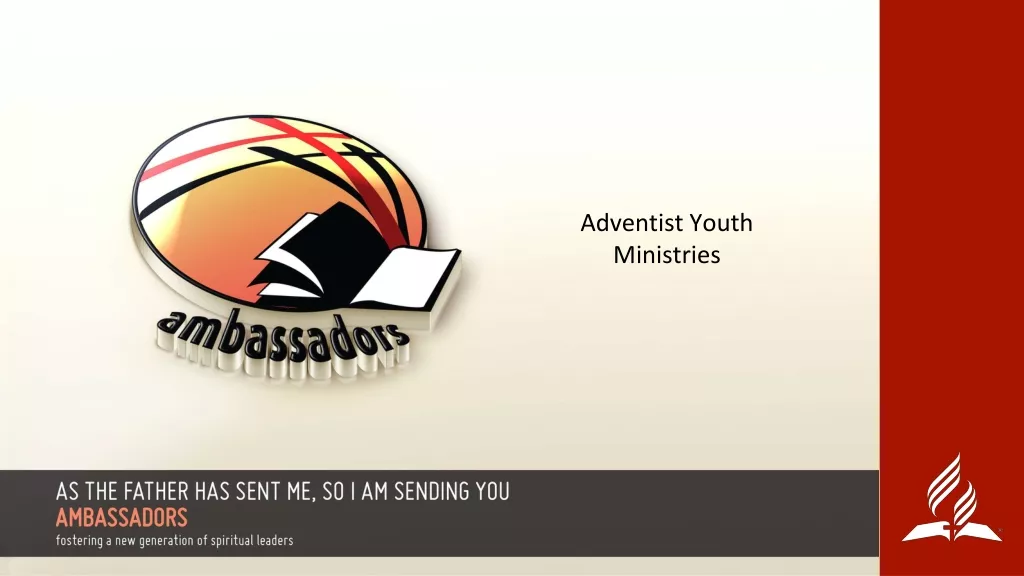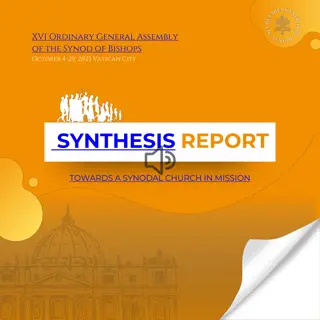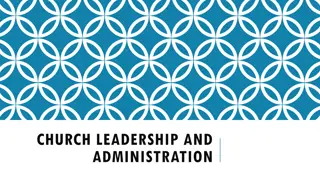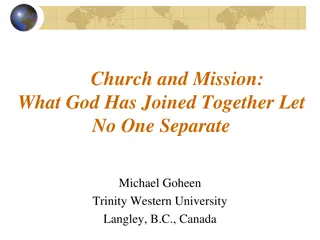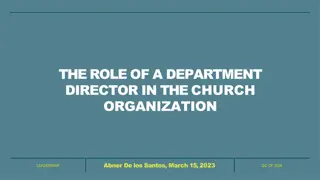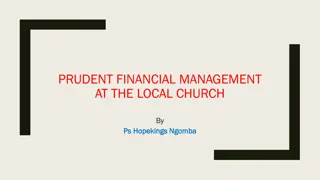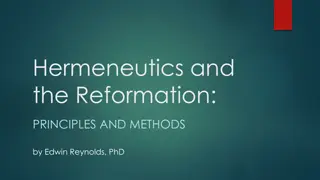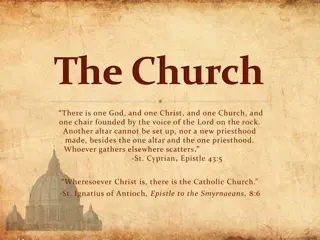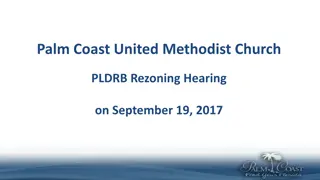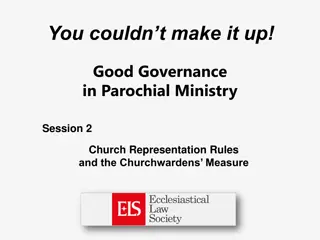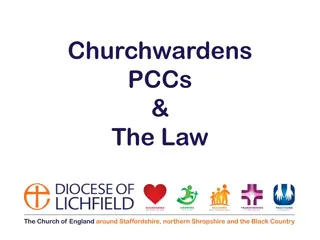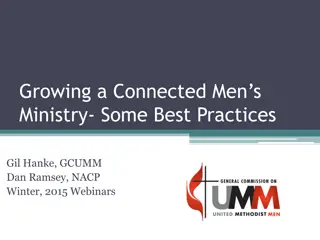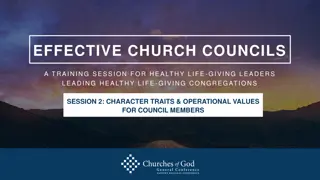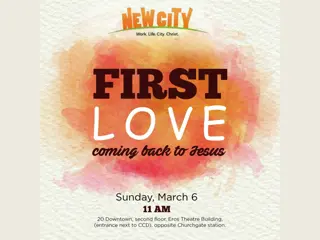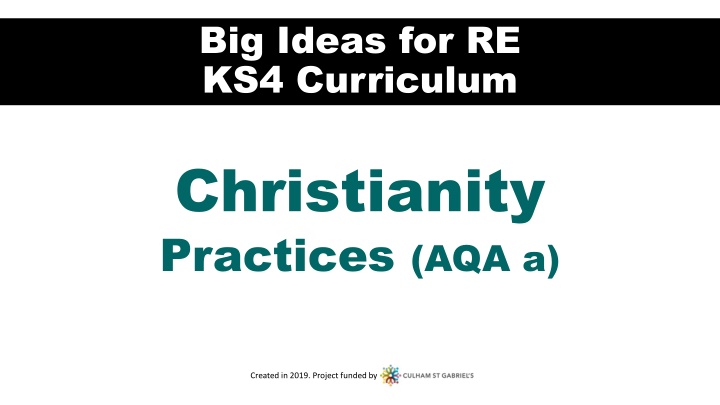
Purpose of the Church in Christianity Practices
Explore the significance of evangelism and mission in Christianity by analyzing the role of the church locally and globally. Delve into the Great Commission of Jesus and the diverse activities of the church as forms of evangelism and growth. Witness how Christian organizations like Christian Aid and Tearfund contribute to the global mission of the church.
Uploaded on | 1 Views
Download Presentation

Please find below an Image/Link to download the presentation.
The content on the website is provided AS IS for your information and personal use only. It may not be sold, licensed, or shared on other websites without obtaining consent from the author. If you encounter any issues during the download, it is possible that the publisher has removed the file from their server.
You are allowed to download the files provided on this website for personal or commercial use, subject to the condition that they are used lawfully. All files are the property of their respective owners.
The content on the website is provided AS IS for your information and personal use only. It may not be sold, licensed, or shared on other websites without obtaining consent from the author.
E N D
Presentation Transcript
Big Ideas for RE KS4 Curriculum Christianity Practices (AQA a) Created in 2019. Project funded by
1 1- -2: 2: What is church for? What is church for? BIG IDEAS LEARNING CONTEXT: Jesus Great Commission CONTEXT: diverse work of the church as forms of evangelism- discuss BELIEFS: Christian duty to evangelise From the spec and street pastors. Mission, evangelism and Church growth. Local church including food banks Worldwide Church: reconciliation, response to persecution Christian Aid/ Tearfund/ CAFOD Learning outcomes: Define mission and evangelism Explain the role of local church with reference to examples Explain the role of church on a global scale with reference to development work Resources Video: https://www.youtube.com/watch?v=BJ0dZhHc cfU 1 Local church 2 Church timeline 2 Reconciliation
Lesson 1 Starter: show spread of Christianity video: https://www.youtube.com/watch?v=BJ0dZhHccfU. Ask the class if they can tell you WHY Christianity spread all over the planet? Show Matt 28: 16-20 (slide). This is known as Jesus Great Commission- a great task or responsibility he gave his disciples. Ask the class what is the task/ responsibility? Christians believe Jesus revealed this mission AFTER his death- ask the class to suggest why this message has massive importance. Relate to spread of Christianity question. Define evangelism and mission . Give an outline of a person image to individuals or pairs. Students add heart, brain, hands, feet, mouth, eyes [instructions on slide]. Read the Corinthians and Ephesians passages about the church as a body. Students label parts of the body with different roles. Share answers. Display various images of churches around the world- from most basic to most ornate, most humble to most important. Ask students to suggest what is most important about a church Read about street pastors on 1 local church . Does this text mention Christianity? Scroll through some pages of the Street Pastors website (https://www.streetpastors.org/). How visible is the Christian element? Discuss whether Street Pastors are engaged in evangelism/ mission. Repeat with info on 1 local church about food banks (I this example we use the Trussel Trust). Are the Christian roots of the Trussel Trust visible? Scroll through some videos and pages of the website. Discuss: is this mission/ evangelism? Discuss the question: What is church for? Record answers. (To continue next lesson )
Jesus Great Commission Jesus Appears to His Disciples The eleven disciples went to the hill in Galilee where Jesus had told them to go. When they saw him, they worshipped him, even though some of them doubted. Jesus drew near and said to them, I have been given all authority in heaven and on earth. Go, then, to all peoples everywhere and make them my disciples: baptize them in the name of the Father, the Son, and the Holy Spirit, and teach them to obey everything I have commanded you. And I will be with you always, to the end of the age. Matt 28: 16-20
Add: Heart, Brain, Hands, Feet, Mouth, Eyes READ: Ephesians and Corinthians passages. These are letters to early church groups in Ephesus and Corinth discussing how they should behave as a group and as individuals. Both letters describe the church as a body . DISCUSSwhat the brain of a church would do, the heart , the hands etc, LABEL these parts of the body. Image reference: https://pixabay.com/photos/outlines-human-person-linear-1866779/
EPHESIANS 4: 11-16 So Christ himself gave the apostles, the prophets, the evangelists, the pastors and teachers, to equip his people for works of service, so that the body of Christ may be built up until we all reach unity in the faith and in the knowledge of the Son of God and become mature, attaining to the whole measure of the fullness of Christ. Then we will no longer be infants, tossed back and forth by the waves, and blown here and there by every wind of teaching and by the cunning and craftiness of people in their deceitful scheming. Instead, speaking the truth in love, we will grow to become in every respect the mature body of him who is the head, that is, Christ. From him the whole body, joined and held together by every supporting ligament, grows and builds itself up in love, as each part does its work. 1 CORINTHIANS 12: 12-14 Just as a body, though one, has many parts, but all its many parts form one body, so it is with Christ. For we were all baptized by one Spirit so as to form one body whether Jews or Gentiles, slave or free and we were all given the one Spirit to drink. Even so the body is not made up of one part but of many.
Lesson 2 Starter: using last week s notes, students answer the question in 5 words: what is church for? Read 2 Church timeline . Ask students to identify what the word church originally meant. Read 2 Reconciliation . Display images of the three communities. Do the class know why ecumenism is necessary? Listen to suggestions Show a stimulus depicting Christian conflict, such as a clip from Elizabeth where Protestants are burned by Mary, or Francois Dubois s painting of the St Bartholomew s Day Massacre, where French Protestants were attacked by Catholics. Show a list of Christian churches in the UK, such as on the Churches Together website (go to membership ). Each church represents a break from the mainstream church. Find out how many there are worldwide. Display an image of Coventry Cathedral s Charred Cross , created from charred wood and rubble after the medieval cathedral was destroyed in the Blitz (Nov 1940). What reconciliation does this symbolise? Define reconciliation . Display an image of the sculpture Reconciliation by Josefina de Vasconcellos. These stand in Coventry Cathedral, Hiroshima, Stormont Castle in Belfast, the Reichstag and Berlin Wall in Berlin. What do these places have in common? What part of the body would reconciliation be done by? Label reconciliation on the Operations board body. Note info about one of the ecumenical churches. Choose two pieces of information studied over the last two lessons, use them to answer the question: what is church for? HW on following slide: Working for Peace (sheet to print in resources; working for peace hw )
HW: Working for Peace 1) Choose ONE of the following charities: - CAFOD www.cafod.org.uk - Christian Aid www.christianaid.org.uk - Tearfund www.tearfund.org 3) Make notes about this project, including Country Source of conflict, type of injustice or persecution what the charity does (max 250 words). 2) Go to their what we do , our campaigns or where we work pages to find specific projects. Find an example of how this charity WORKS FOR PEACE; whether in situations of war, injustice or persecution. 4) Note if this charity is linked to a particular Christian church, or if it is a specifically Christian charity.


